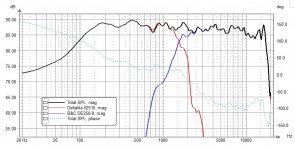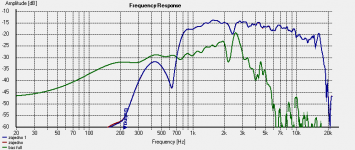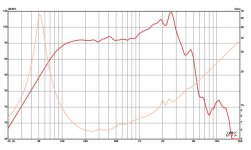Here are FRD and ZMA for Eminence Deltalite II2510 and B&C DE250-8 compression driver in 18sound XT1086 waveguide.
Measuring distance about 120cm, on tweeter axis. Center of midbas is 24cm below tweeter. Front panel is 50cm high and 30cm wide.
Files are gated at about 230Hz. I've played with it a little bit.
Measuring distance about 120cm, on tweeter axis. Center of midbas is 24cm below tweeter. Front panel is 50cm high and 30cm wide.
Files are gated at about 230Hz. I've played with it a little bit.
Attachments
Last edited:
Here is factory and measured frequency response. Disregard the blue line which represents combined Deltalite and DE250 for Z axis distance determination. Green is Deltalite II 2510.
They are pretty similar apart from dip at 2,2KHz that looks way better on factory curve. Is it smoothed on purpose or is this factory tolerance i wouldn't know but it is there. One notch filter worked like a charm and flattened it, as can be seen from sim above.
Baffle step occuring at about 380Hz is clearly visible and matches the calculation.
f3 = 115 / WB (where WB is the baffle width in meters)
f3 = 380 / WB (where WB is the baffle width in feet)
They are pretty similar apart from dip at 2,2KHz that looks way better on factory curve. Is it smoothed on purpose or is this factory tolerance i wouldn't know but it is there. One notch filter worked like a charm and flattened it, as can be seen from sim above.
Baffle step occuring at about 380Hz is clearly visible and matches the calculation.
f3 = 115 / WB (where WB is the baffle width in meters)
f3 = 380 / WB (where WB is the baffle width in feet)
Attachments
Last edited:
On what grounds have you chosen such a high x/o frequency? For a 10" woofer 1600 Hz is quite high.
I am not familiar with the off axis curves of the 2510, but assume crossing somewhat lower will yield a better match between woofer and tweeters' off axis curves. The DE 250 will -in home applications at least- certainly survive 1000 Hz or so.
Regards,
Eelco
I am not familiar with the off axis curves of the 2510, but assume crossing somewhat lower will yield a better match between woofer and tweeters' off axis curves. The DE 250 will -in home applications at least- certainly survive 1000 Hz or so.
Regards,
Eelco
Eelco,
Download the .frd & .zma files ( inside the zipped ) folder that Zvu posted above .
Then import them into either XSim, WinPCD or PCD7 .
Once imported, you too can try your hand at creating your own preferred X-over .
I suspect that's why Zvu included the word "playground" within the title of his thread.
🙂
PS; In a very similar vein, there's plenty of good reference stuff in a thread called FLEX Your PCD Mettle (which was a classic "Zilch thread" located over at TechTalk). There's even a project that uses the same components as this ).
Download the .frd & .zma files ( inside the zipped ) folder that Zvu posted above .
Then import them into either XSim, WinPCD or PCD7 .
Once imported, you too can try your hand at creating your own preferred X-over .
I suspect that's why Zvu included the word "playground" within the title of his thread.
🙂
PS; In a very similar vein, there's plenty of good reference stuff in a thread called FLEX Your PCD Mettle (which was a classic "Zilch thread" located over at TechTalk). There's even a project that uses the same components as this ).
Okay, so I've "played" and here's my piece of fiction .

This is a "P.A. version" ( an attempt at maintaining high efficiency, with a benign impedance load, as well as maintaining absolute polarities of the two drivers ) .
This would need to be built & then tested to see if the ( lowish ) 1K crossover point would hold up under max input (ie; what would the distortion products actually look like ).
The variable Lpad ( seen in blue ) would invariably be rolled into the fixed Lpad ( for PA duty ).
🙂

This is a "P.A. version" ( an attempt at maintaining high efficiency, with a benign impedance load, as well as maintaining absolute polarities of the two drivers ) .
This would need to be built & then tested to see if the ( lowish ) 1K crossover point would hold up under max input (ie; what would the distortion products actually look like ).
The variable Lpad ( seen in blue ) would invariably be rolled into the fixed Lpad ( for PA duty ).
🙂
Last edited:
On what grounds have you chosen such a high x/o frequency? For a 10" woofer 1600 Hz is quite high.
I am not familiar with the off axis curves of the 2510, but assume crossing somewhat lower will yield a better match between woofer and tweeters' off axis curves. The DE 250 will -in home applications at least- certainly survive 1000 Hz or so.
Regards,
Eelco
Hi Boden,
DE250-8 can survive 1KHz but the 18sound XT1086 waveguide doesn't hold horizontal directivity that low. I would need bigger waveguide to make xover frequency at 1KHz. Horizontal coverage of XT1086 is 80deg so 40deg to the left or to the right yields -6dB drop in frequency response at about 1200Hz loaded with DE250. So 1200Hz is primary goal. 1600Hz xover sim is to get the party started.
As Earl noticed, this project started as one of Zilchs econowaves but it grew to a three way using 15" for bass. Xover point between woofer and mid will be arround 150-250Hz and we will play with mid-high xover point just to see what sounds best.
Eelco,
Download the .frd & .zma files ( inside the zipped ) folder that Zvu posted above .
Then import them into either XSim, WinPCD or PCD7 .
Once imported, you too can try your hand at creating your own preferred X-over .
I suspect that's why Zvu included the word "playground" within the title of his thread.
🙂
PS; In a very similar vein, there's plenty of good reference stuff in a thread called FLEX Your PCD Mettle (which was a classic "Zilch thread" located over at TechTalk). There's even a project that uses the same components as this ).
Spot on 🙂
Okay, so I've "played" and here's my piece of fiction .

This is a "P.A. version" ( an attempt at maintaining high efficiency, with a benign impedance load, as well as maintaining absolute polarities of the two drivers ) .
This would need to be built & then tested to see if the ( lowish ) 1K crossover point would hold up under max input (ie; what would the distortion products actually look like ).
The variable Lpad ( seen in blue ) would invariably be rolled into the fixed Lpad ( for PA duty ).
🙂
Great stuff Earl, as always. Adding high power subwoofer would make it a mean party machine 🙂
Last edited:
Hello Earl,
Thanks for the PE/Econowave link. That thread, however, demonstrates the background of my question to Zvu, and that is that while flat on axis (or B&K sloping) is mandatory, it is off axis where the action is.
Simulating on axis only is not going to get you there. But hey, that is stating the obvious, isn't it?
BTW: Zvu answered my question.
Eelco
Thanks for the PE/Econowave link. That thread, however, demonstrates the background of my question to Zvu, and that is that while flat on axis (or B&K sloping) is mandatory, it is off axis where the action is.
Simulating on axis only is not going to get you there. But hey, that is stating the obvious, isn't it?
BTW: Zvu answered my question.
Eelco
I'd have guessed 1600Hz was better than crossing lower.
I will make few simulations for different xover frequencies. Then we will listen to them one at a time to hear what sounds the best. After that there is a tweaking to the listeners preference and that should be it.
Do you have any experience with driver combination similar to this ?
Last edited:
Hello Zvu,
Once you have settled for a favourite setting x/o/ wise, would you be willing to make and post a number of horizontal off axis measurements e.g. 30/45/60?
Thanx in advance and good luck with this venture.
Eelco
Once you have settled for a favourite setting x/o/ wise, would you be willing to make and post a number of horizontal off axis measurements e.g. 30/45/60?
Thanx in advance and good luck with this venture.
Eelco
Hi,
Here's another variant ( a 3 over 2, just for the heck of it ).

- This has the same parts count as my first ( 10 ) / I'm simply demonstrating a different approach.
- This does sport a safer crossover-point for the HF driver ( @ 1600hz ).
- Unfortunately, there's broader overlap in the 1K-3K region ( with more resultant attenuation of HF circuit , 2K-3K ). This could result in a noticable "swooshing" sound ( with head movement ) if the polars start to really fall apart off-axis ( I wouldn't know without a lot more exploration / just thinking out-load).
- ( Somewhat disturbing ) is the cone breakup of the 10" woofer is now 10db louder than my first pass ( this may not be a good-thing ).
- BTW, L3 is not actually in the circuit ( it's just a placeholder & represents a straight piece of wire ).
🙂
Here's another variant ( a 3 over 2, just for the heck of it ).

- This has the same parts count as my first ( 10 ) / I'm simply demonstrating a different approach.
- This does sport a safer crossover-point for the HF driver ( @ 1600hz ).
- Unfortunately, there's broader overlap in the 1K-3K region ( with more resultant attenuation of HF circuit , 2K-3K ). This could result in a noticable "swooshing" sound ( with head movement ) if the polars start to really fall apart off-axis ( I wouldn't know without a lot more exploration / just thinking out-load).
- ( Somewhat disturbing ) is the cone breakup of the 10" woofer is now 10db louder than my first pass ( this may not be a good-thing ).
- BTW, L3 is not actually in the circuit ( it's just a placeholder & represents a straight piece of wire ).
🙂
I have some 2510's and a pair of de250 copies.
I have seos12 waveguides, but am willing to change the wg if someone designs a good crossover.
I have pcd7 but am too new to it to be of help.
I will be watching this thread with interest.
I have measurement gear, but winter is almost here and no room inside to measure at this moment. I love measuring. Maybe by spring i can post something.
I have seos12 waveguides, but am willing to change the wg if someone designs a good crossover.
I have pcd7 but am too new to it to be of help.
I will be watching this thread with interest.
I have measurement gear, but winter is almost here and no room inside to measure at this moment. I love measuring. Maybe by spring i can post something.
I take polar measurements of both drivers before I choose the initial crossover point. I watch for issues in each driver and calculate their power response. The woofer tends to get close to its breakup region.Do you have any experience with driver combination similar to this ?
Mine are sims but soon to be measured. I have polars of de250/wg combo. Holds up to 1.2Khz. And i have bunch of measurements for Eminence 10" delta/deltalite posted on diysoundgroup.
Here are measurements for Fusion 10 Max speaker kit. It uses 2x10" amd Seos 10 in mtm. Xover frequency at about 1500Hz, so i think 1200Hz target will work.
Cheers
Here are measurements for Fusion 10 Max speaker kit. It uses 2x10" amd Seos 10 in mtm. Xover frequency at about 1500Hz, so i think 1200Hz target will work.
Cheers
An externally hosted image should be here but it was not working when we last tested it.
An externally hosted image should be here but it was not working when we last tested it.
I take polar measurements of both drivers before I choose the initial crossover point. I watch for issues in each driver and calculate their power response. The woofer tends to get close to its breakup region.
If these polars have information about diffraction then you can decide how bad it is to cross low.Mine are sims but soon to be measured. I have polars of de250/wg combo. Holds up to 1.2Khz.
The woofer should be narrowing to meet the tweeter. The woofer size sets the crossover. 1900Hz is one good place to cross and it is the highest I would try. The lowest is around 1100Hz.
If these polars have information about diffraction then you can decide how bad it is to cross low.
The woofer should be narrowing to meet the tweeter. The woofer size sets the crossover. 1900Hz is one good place to cross and it is the highest I would try. The lowest is around 1100Hz.
We're thinking very similar. That's why i'll make 3 versions of xovers 1200/1400/1600 and then measure and listen to them.
I'll post the results here.
Last edited:
- Home
- Loudspeakers
- Multi-Way
- Deltalite II2510 and B&C DE250-8 on 18sound XT1086 playground



